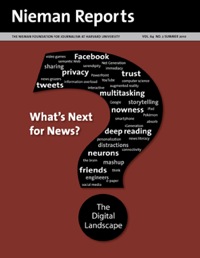 [Our sister publication Nieman Reports is out with its latest issue, and its focus is the new digital landscape of journalism. There are lots of interesting articles, and we’ve been highlighting a few. Here, Nieman Reports assistant editor Jan Gardner talks with MIT’s V. Michael Bove, Jr., co-director of the Center for Future Storytelling. —Josh]
[Our sister publication Nieman Reports is out with its latest issue, and its focus is the new digital landscape of journalism. There are lots of interesting articles, and we’ve been highlighting a few. Here, Nieman Reports assistant editor Jan Gardner talks with MIT’s V. Michael Bove, Jr., co-director of the Center for Future Storytelling. —Josh]
V. Michael Bove, Jr.: Our effort at the center looks very broadly at the ways in which people will express themselves and share stories and at the different tensions involved in doing this. There are two that I particularly care about. The first is the tension between the shared social experience of inviting You can become your own director. Or you can decide to have a lean-back experience. So it’s not like playing a video game. You don’t constantly have to be pressing buttons or moving around to make the story advance. But if you want to invest more in it, you can get more in return.friends over to watch the Super Bowl on your big screen TV versus people who watch TV on their iPhones wanting to have a personalized interactive experience. How do you simultaneously create what will be a shared experience and a personalized experience such that everybody comes away happy?
The second tension is between large organizations — such as Disney-Pixar — which do very good storytelling by getting the best talent and having a culture that nurtures what they do — and the YouTube generation. How do you support both of those visions without casting them in opposition to each other? How do you look hard at the business models, content and technologies with some meeting of the minds, in ways in which each side feels that there’s some benefit in talking with the other?
Recently we had about 150 people at an event called Story 3.0. A big part of that gathering was an attempt to figure out what people are already doing that relates to these questions, as well as some interesting directions to follow up on.